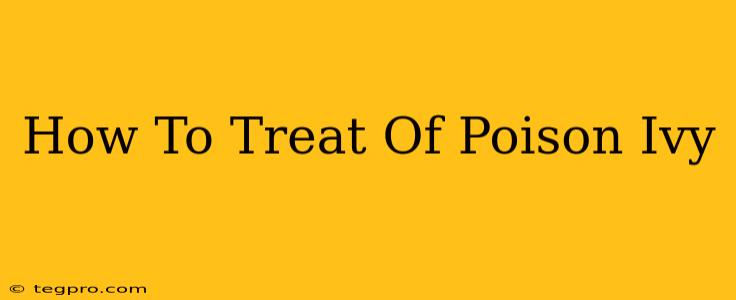Poison ivy. Just the name conjures up images of itchy, blistering rashes. But understanding how to treat poison ivy effectively can significantly reduce discomfort and prevent complications. This guide provides a comprehensive overview of treatment options, from recognizing the plant to managing severe reactions.
Identifying Poison Ivy: The First Step
Before we delve into treatment, it's crucial to correctly identify poison ivy. Misidentification can lead to unnecessary worry or, worse, delayed treatment for a different skin condition. Remember the saying: "Leaves of three, let it be." Poison ivy typically has three leaflets, with the middle leaflet having a longer stem than the other two. The leaves can vary in color throughout the year, ranging from red in spring to green in summer and reddish or yellow in autumn. Beware: Poison ivy can grow as a vine, a shrub, or even groundcover.
Immediate Actions After Exposure
Time is of the essence! The sooner you act after coming into contact with poison ivy, the better your chances of minimizing the reaction.
1. Wash Thoroughly:
This is the most critical step. Within 30 minutes of exposure, wash the affected area thoroughly with soap and cool water. Use a generous amount of soap and scrub gently but effectively. This helps remove urushiol, the oily resin that causes the allergic reaction. Consider using rubbing alcohol or a specialized poison ivy wash if available.
2. Remove Contaminated Clothing:
Wash all clothing and gear that may have come into contact with poison ivy separately in hot, soapy water. Do not shake out clothing, as this can spread the urushiol.
3. Wash Your Tools:
If you used gardening tools or any equipment while working near poison ivy, wash them thoroughly as well. Urushiol can linger on surfaces.
Treating the Poison Ivy Rash: Home Remedies & Medical Options
Once a rash develops, several strategies can help manage the itching and inflammation:
Home Remedies:
- Cool Compresses: Applying cool, wet compresses can provide soothing relief from itching and inflammation.
- Calamine Lotion: This over-the-counter medication is a time-tested remedy for relieving itching associated with poison ivy.
- Oatmeal Baths: Colloidal oatmeal baths can help soothe irritated skin. Look for products specifically designed for this purpose.
- Baking Soda Paste: A paste of baking soda and water can help neutralize the urushiol and reduce inflammation.
Medical Treatments:
For more severe reactions or if home remedies aren't effective, consult a doctor. They may prescribe:
- Corticosteroid Creams: These powerful creams can effectively reduce inflammation and itching.
- Oral Corticosteroids: In severe cases, oral corticosteroids may be necessary to control the inflammation.
- Antihistamines: Oral antihistamines can help reduce itching.
- Prescription-Strength Topical Treatments: Your doctor may recommend other topical treatments.
Preventing Future Exposure to Poison Ivy
Prevention is key! Here are some tips to avoid future encounters with this pesky plant:
- Learn to Identify Poison Ivy: Familiarize yourself with its appearance in different seasons.
- Wear Protective Clothing: When venturing into areas where poison ivy is prevalent, wear long sleeves, long pants, and gloves.
- Use Barrier Creams: Some barrier creams can help prevent urushiol from coming into contact with your skin.
- Use caution when burning: Burning poison ivy releases urushiol into the air, leading to inhalation and potentially severe reactions.
When to Seek Medical Attention
While most poison ivy rashes resolve without complications, seek immediate medical attention if you experience:
- Severe Swelling: Especially around the face or genitals.
- Difficulty Breathing: This indicates a severe allergic reaction.
- Widespread Rash: Covering a large portion of your body.
- Fever: This may indicate a secondary infection.
- No improvement after a week of home treatment.
By understanding how to identify, treat, and prevent poison ivy, you can minimize discomfort and enjoy the outdoors worry-free. Remember, early intervention and proper treatment are crucial for managing this common yet irritating skin condition.

